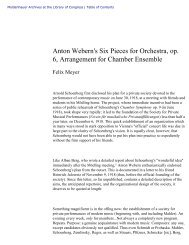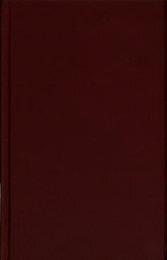Country Profile: Cuba - American Memory - Library of Congress
Country Profile: Cuba - American Memory - Library of Congress
Country Profile: Cuba - American Memory - Library of Congress
You also want an ePaper? Increase the reach of your titles
YUMPU automatically turns print PDFs into web optimized ePapers that Google loves.
<strong>Library</strong> <strong>of</strong> <strong>Congress</strong> – Federal Research Division <strong>Country</strong> <strong>Pr<strong>of</strong>ile</strong>: <strong>Cuba</strong>, September 2006<br />
involvement in the economy, particularly in agricultural food production, transport, and tourism<br />
(through the military-linked Gaviota Tourism Group, S.A.).<br />
Major Military Units: The full establishment <strong>of</strong> a mobilized <strong>Cuba</strong>n infantry division is 5,900<br />
members; a mechanized division, 8,200; and an armored division, 6,200. A <strong>Cuba</strong>n infantry<br />
regiment numbers 1,010 personnel, and each <strong>of</strong> its two battalions numbers 349 soldiers. Armored<br />
regiments consist <strong>of</strong> 720 personnel; each <strong>of</strong> their three tank battalions has about 110 soldiers and<br />
21 tanks; artillery regiments have about 975 personnel. In early 2006, the army had four or five<br />
armored brigades, nine mechanized brigades, one airborne brigade, and one artillery group. In<br />
addition, the army included between 12 and 14 reserve infantry brigades. It was deployed<br />
regionally in the Western Army, Central Army, and Eastern Army. In addition, the Isla de la<br />
Juventud Military Region was garrisoned by forces equivalent to an infantry brigade. The<br />
Revolutionary Army Command included an airborne brigade and an artillery division. The<br />
Western Army included two mixed security regiments: one consisted <strong>of</strong> four divisions (brigade<br />
equivalents); the other, called the 2 nd Pinar del Río Army Corps, consisted <strong>of</strong> three infantry<br />
divisions (brigades). The Central Army comprised three mixed security regiments, four infantry<br />
divisions (brigades), and the 4 th Las Villas Army Corps, which consisted <strong>of</strong> three infantry<br />
brigades. The Eastern Army included 10 divisions (brigades), the Guantánamo Frontier Guard<br />
Brigade (comprising two infantry regiments), the 5 th Holguín Army Corps (comprising one<br />
mechanized and four infantry divisions/brigades), and the 6 th Camagüey Army Corps (consisting<br />
<strong>of</strong> one mechanized brigade and three infantry brigades).<br />
Major military units <strong>of</strong> the rest <strong>of</strong> the armed forces also are divided into the western, central, and<br />
eastern regions. The three main territorial divisions <strong>of</strong> the air force and their responsible brigades<br />
are the Western Air Zone (the Bay Of Pigs Guard Brigade), the Central Air Zone (the Batalla de<br />
Santa Clara Guard Brigade), and the Eastern Air Zone (the Cuartel Moncada Guard Brigade).<br />
The nearly nonoperational navy, which is divided into the Western Naval District and the<br />
Eastern Naval District, has naval bases in Cabañas, Nicaro, Cienfuegos, Havana, Santiago de<br />
<strong>Cuba</strong>, and Banes.<br />
Major Military Equipment: Although the army is well stocked with Russian equipment, much<br />
<strong>of</strong> it is obsolete or aging, and there is a critical shortage <strong>of</strong> spare parts. Most <strong>of</strong> <strong>Cuba</strong>’s equipment<br />
came from the former Soviet Union and its East European allies, primarily Czechoslovakia and<br />
Poland. Under a 2000 accord, Russia is supposed to assist <strong>Cuba</strong> in modernizing its inventory. In<br />
the meantime, China has become <strong>Cuba</strong>’s main supplier <strong>of</strong> arms.<br />
<strong>Cuba</strong> reportedly has about 1,500 to 1,700 armored military vehicles in service. In 2005 the army<br />
inventory included an estimated 900 main battle tanks, including 400 T–62s (200 in service) and<br />
1,100 T–54/55s (500 in service). Other armored vehicles included 50 PT–76 amphibious light<br />
tanks (30 in service), 100 BRDM–1/–2 reconnaissance vehicles (about 90 in service), 400 BMP–<br />
1 armored infantry fighting vehicles (about 150 in service), and 700 BTR–40/–50/–60/–152<br />
armored personnel carriers (300 in service). The army’s artillery included 37 self-propelled<br />
howitzers, 500 towed pieces, and about 175 BM–14 and BM–21 multiple rocket launchers. In<br />
addition, the army had 1,000 mortars.<br />
30



![Albert Einstein Papers [finding aid]. Library of Congress. [PDF ...](https://img.yumpu.com/21604228/1/190x245/albert-einstein-papers-finding-aid-library-of-congress-pdf-.jpg?quality=85)





![American Colony in Jerusalem Collection [finding aid]. Library of ...](https://img.yumpu.com/17941275/1/190x245/american-colony-in-jerusalem-collection-finding-aid-library-of-.jpg?quality=85)



![Piccard Family Papers [finding aid]. - American Memory - Library of ...](https://img.yumpu.com/17941234/1/190x245/piccard-family-papers-finding-aid-american-memory-library-of-.jpg?quality=85)


